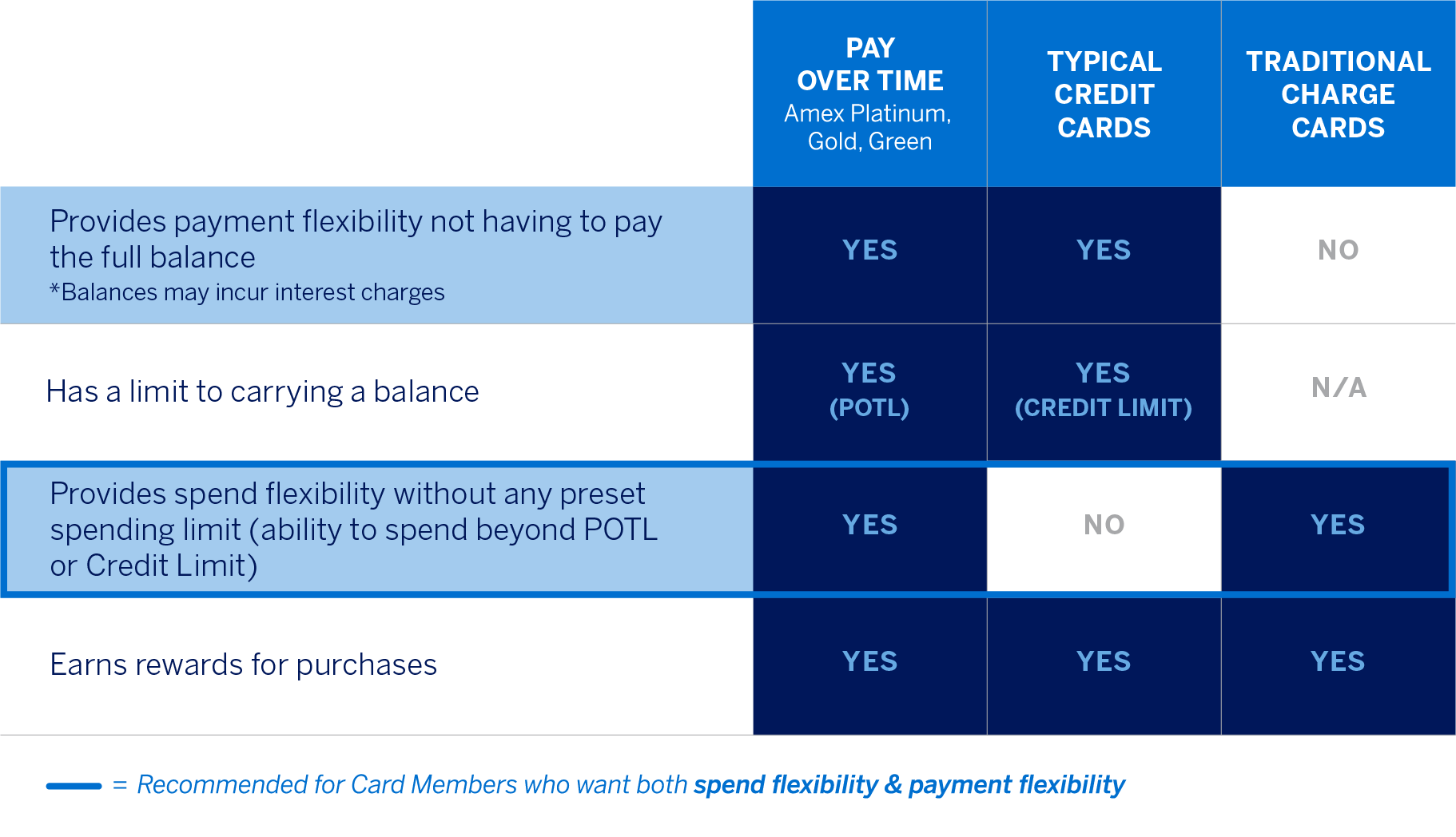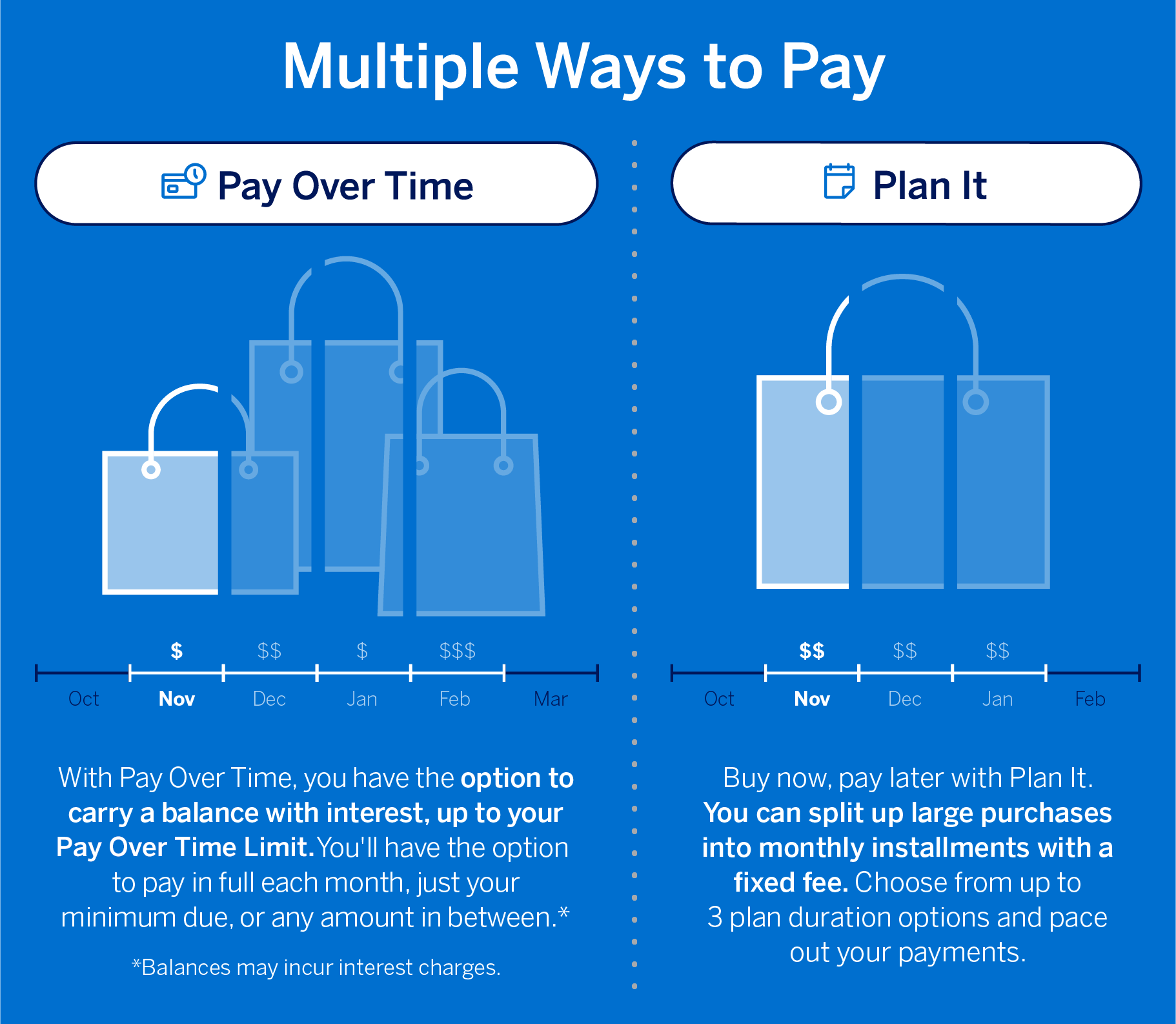7 Min Read | Updated: April 30, 2024
Do I Have to Pay My Credit Card in Full Every Month?
Paying your card balance in full keeps interest and debt at bay, but choosing to pay over time can afford financial flexibility when paying off major purchases.
At-A-Glance
Credit cards don’t need to be paid in full every month, but doing so prevents interest charges from accruing and debt from accumulating.
Even so, carrying a balance with interest can be an effective way to finance major purchases, like home renovations and car repairs.
Traditional charge cards, however, must be paid in full every month.
Some cards offer flexible payment options that provide their card members with more control.
Spending isn’t static. Our lives – and the economy – are constantly changing. Frustratingly, a necessary purchase may come along when money’s tight. And even when money isn’t tight, sometimes it’s better to have the flexibility to pay off expenses over time.
Fortunately, credit cards don’t need to be paid off in full every month. You can carry a balance at the expense of interest charges. However, that’s not the case for traditional charge cards, where the balance must be paid in full each month.
Some cards, including the American Express® Platinum Card, the American Express® Gold Card, and the American Express® Green Card, offer flexible payment options that provide Card Members with more control. Thanks to the easy-to-use American Express Pay Over Time feature, Card Members can decide if and when to carry a balance with interest, up to their Pay Over Time Limit, rather than paying in full each month.
This article explores how responsibly carrying a balance can provide you with the financial flexibility to confidently make major purchases. We’ll also take a closer look at how Pay Over Time works, what the Pay Over Time Limit is, and what makes this feature different from a traditional credit card.
Should I Pay My Card in Full Every Month?
Common wisdom says that it’s best to pay off your credit card statement balance in full every month. By doing so, you can avoid interest charges and help stave off debt. For those who use charge cards, a full payment at the end of every statement period is required. The requirement to pay monthly statements in full is part of what defines a traditional charge card, along with having no preset spending limit.
Both credit and charge cards usually have a grace period – the time between the end of your billing cycle and your payment due date, in which interest typically won’t be charged (provided you are not carrying a balance).1 In other words, just using a credit or charge card for purchases could afford you a couple of weeks to pay them off before having to pay interest – as long as your card issuer offers a grace period and you’ve been paying your monthly statement balance in full and on time each month.
So, you should pay your card’s statement balance in full each month by the payment due date if you want to avoid interest charges. And, as long as you pay in full by the payment due date, you’ll reap the benefits of the grace period.
Carrying a Balance Can Be Helpful, But Has Costs
What happens when you want to pay off a necessary purchase over time, but the grace period isn’t long enough to match your budgeting needs? With the ability to carry a balance, credit cards can come in handy, even though they charge interest. Their payment flexibility can go a long way toward managing monthly expenses, especially if you mindfully carry the balance and make a plan to pay it off. For example, car repairs can be costly and unexpected. Charging the transaction to a credit card can grant you the convenience to pay it off over several months so it takes a smaller bite out of your budget.
To help cut down on overall interest charges, you can make multiple small payments – maybe weekly – instead of waiting to make a bigger payment on the payment due date each month. That lowers your average daily balance, which is used to calculate credit card interest charges. Or you can consider using a 0% intro APR credit card, which makes it possible to carry a balance without interest for as long as the promo period lasts. This makes for a cost-effective way to finance predictable big ticket purchases.
While charge cards boast unique benefits like the ability to make bigger purchases without maxing out the card, they traditionally require every statement balance to be paid off in full, on time. Otherwise, expect late payment fees and potential impacts to your credit history.
Pay Over Time: A Convenient Way to Have More Ways to Pay
The American Express Platinum, Gold, and Green Cards have no preset spending limit. No preset spending limit means the spending limit is flexible. Unlike a traditional credit card with a set limit, the amount you can spend adapts based on factors such as your purchase, payment, or credit history – giving you the flexibility to unlock more purchase power as you use your Card.
When active, the Pay Over Time feature enables Card Members to choose whether they want to carry a balance, with interest, up to their Pay Over Time Limit (more on this below). Any balance that exceeds your Pay Over Time Limit must be paid in full by your payment due date, and interest is charged only if and when you choose to carry a Pay Over Time balance.2
Additionally, using Pay Over Time has no impact on how Card Members earn and redeem Membership Rewards® points.

How Does Pay Over Time Work?
Say you typically use your Amex Gold Card for grocery and dining purchases and always pay your statement balance in full. But you’re planning a DIY remodel of your bedroom and know it’s going to cost a pretty penny. One option is to charge those remodeling expenses to your Gold Card.
This has a few benefits. For one, you’ll get to earn some rewards. And, like a traditional charge card, you can have a flexible spending limit. Better yet, when it’s time to pay your bill, you’ll have two options:
- Pay your balance in full.
- Carry a balance, up to your Pay Over Time Limit, and pay it off over time with interest – similar to a typical credit card.
From paying your balance in full, the minimum due, or any amount in between each month – Pay Over Time allows you to select how much of your balance you’d like to pay and then carry the rest with interest up to your Pay Over Time Limit.
But remember: If you want to use Pay Over Time, the feature must be activated before you make the charges you intend to pay over time. If the feature wasn’t active, you can’t retroactively add charges to your Pay Over Time balance. Once Pay Over Time is active, charges will be added to the Pay Over Time balance, up to the Pay Over Time Limit.
Tip: Activating Pay Over Time to carry a balance with interest, up to your Pay Over Time Limit, doesn’t require an additional credit check or impact your standing with American Express.
You can always deactivate the Pay Over Time feature if you’d prefer to use your account as a traditional charge card. Card Members can change their setting on their online account, mobile app, or call in for assistance.
Of course, it can be reactivated if and when you choose to take advantage of Pay Over Time’s additional payment flexibility in the future – perhaps you’re planning a luxurious honeymoon and want to pay it off at your own pace.
What Is the Pay Over Time Limit?
Your Pay over Time Limit is the maximum amount you can carry as a balance with interest on your Card, or move into a plan with a fixed monthly fee. This limit applies to the total of your Pay Over Time, Cash Advance, and Plan It® balances. Your Pay Over Time Limit is not a spending limit. Any charges you make above the Pay Over Time Limit will be due in full each month.
Tip: You can view your Pay Over Time Limit at any time by logging into your American Express online account and clicking Balance Details.
In other words, you can spend beyond your Pay Over Time Limit – you’ll just need to pay for any new purchases in full when your bill is due. So remember: your Pay Over Time Limit is the maximum amount you can carry with interest or put into a plan with Plan It, not how much you can spend.

What About Plan It®?
Plan It is another payment flexibility option offered by Amex, but it works a bit differently than Pay Over Time. Specifically, Plan It allows eligible Card Members to split purchases of $100 or more into equal monthly installments with a fixed fee so you can know upfront exactly how much you’ll pay and when. You can put up to 10 eligible transactions into one plan.
Before creating a Plan, Card Members will be presented with up to three different plan duration options, allowing them to choose the one that works best for their needs. This added flexibility can be a great way to get extra breathing room in your budget, while paying off a purchase in a concrete, predictable way – and still earning rewards the way you usually do.
A key difference between Plan It and Pay Over Time is that Plan It lets you select large purchases – like a set of new tires, or a new refrigerator – to split into equal monthly installments with a fixed fee, up to your Pay Over Time Limit, similar to a buy now, pay later arrangement. Pay Over Time, on the other hand, makes it possible to carry a balance with interest up to your Pay Over Time Limit, like a typical credit card revolving balance. This can be a useful way to finance larger balances at your own pace, rather than in fixed installments.

The Takeaway
While it’s generally best to pay off your credit card balance in full every month to avoid paying interest, doing so isn’t always realistic. Typical credit cards let card members carry a balance with interest, which can afford needed payment flexibility. But unlike charge cards, they have credit limits – which can get in the way of milestone purchases. Thanks to the American Express Pay Over Time feature, Cards like The Platinum Card, the Amex Gold Card, and the Amex Green Card offer the best of both worlds and provide Card Members with more ways to pay their bill.
1 “What is a grace period for a credit card?,” Consumer Financial Protection Bureau
2 For charges added automatically to a Pay Over Time balance, we will charge interest beginning on the date of each charge. We will not charge interest on charges automatically added to your Pay Over Time balances if you pay the Account Total New Balance by the Payment Due Date each month. You must pay in full, by the Payment Due Date, all charges that are not added to a Pay Over Time, Cash Advance, or Plan balance. We will begin charging interest on cash advances on the transaction date.
Megan Doyle is a business technology writer and researcher whose work focuses on financial services and cross-cultural diversity and inclusion.
All Credit Intel content is written by freelance authors and commissioned and paid for by American Express.
Related Articles
Should I Pay for Dental Care with a Credit Card?
Even if you have dental insurance, you can still face out-of-pocket costs. Paying for dental care with a credit card can help, but it’s not always the best idea.
How and When to Pay Your Credit Card Bill
It’s important to pay your credit card bill in full – and on time – each month. Here’s what you need to know.
What Happens When You Pay the Minimum on Your Credit Card?
Making only a credit card’s minimum payment can greatly extend the time it takes to pay a balance, and drive up interest costs. But it can make sense—occasionally.
The material made available for you on this website, Credit Intel, is for informational purposes only and intended for U.S. residents and is not intended to provide legal, tax or financial advice. If you have questions, please consult your own professional legal, tax and financial advisors.











